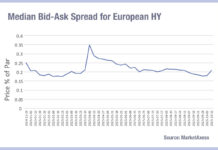MiFID II and electronification are transforming the credit market – How can one benefit from this new environment to access liquidity and how can a stock exchange help? Nathalie Masset, Head of Fixed Income at Euronext provides some answers.
What are the constraints brought by MiFID II and the electronification of markets?
Everyone agrees that we are in the middle of a major evolution in the institutional fixed income markets. We are moving towards a more regulated and generally more electronic environment. Basel III encouraged additional electronic trading, a shift to agency models and an increase in buy-side inventories.
There were, however, unintended consequences, as liquidity became harder to find. This “invisible” liquidity is difficult to source and access; it’s “sleepy” liquidity.
MiFID II – with its dynamic instrument classification criteria and phased liquidity thresholds – will provide an additional push towards new, electronic solutions.
What are the issues to solve?
When we look at key priorities today in institutional fixed income markets – especially in the credit space – we can identify the following needs:
• Comply with MiFID II while using pre and post-trade transparency waivers to protect interests;
• Choose the right protocol depending on the bond type, liquidity level and transaction size;
• Develop cost-efficiency across the value chain – especially considering the massive cost incurred by the industry to become MiFID II compliant;
• Find new ways to access and amalgamate liquidity and increase execution possibilities;
• Protect the interests of market participants on both sides of the market and allow them to evolve in a confidential environment during the whole trading process.
Customers expect banks to play several important roles:
• Intermediate access to different pools of liquidity and finding potential counterparties;
• Help price bonds;
• Route and executing orders in a regulation-compliant environment;
• Take care of the post-trade;
• Provide them with trading and data solutions that are as automated and STP as possible and include best selection and best execution.
This leads banks to look at new initiatives and consider new models to enhance the services they provide to their customers.
Where is innovation?
The industry needs to ease access to liquidity in a cost-efficient way while coping with new regulation and respecting the existing relationships between the sell and the buy sides.
Building new trading protocols? Most protocols needed by the industry already exist and will remain after MiFID II. What is changing is that they are becoming more electronic – even if voice will remain for very large sizes – and that they must be completed with publication and reporting mechanisms.
Building new routes to access liquidity? The fixed income market will remain fragmented as MiFID II is not going to bring that much transparency. There’s definitely room for innovation in easing the identification of potential counterparties – especially for blocks in the illiquid credit space. It is about building communities and networks of market participants, linked together thanks to intelligent algorithms allowing them to connect to the most appropriate counterparties with no leakage of information on the market.
Euronext’s strategy and offer in the fixed income space
Euronext already provides markets with a standard set of services including fast-track membership, market surveillance, publication to the market and reporting to regulators.
In the current context, we saw a great opportunity to bring a new solution and accompany fixed income markets as they embrace electronic trading in their quest for liquidity. Therefore, we decided to build a Multi-lateral Trading Facility (MTF) – Euronext Synapse – to address a specific segment of the fixed income markets: large, illiquid corporate and financial bonds.
We provide workflows that respect the intermediary role of the sell side, protect the buy side’s interests and ensure full confidentiality of the trading process. The liquidity and counterparty discovery as well as the bilateral negotiations are done in a fully confidential and anonymous environment with no risk of information leakage.
We developed our MTF through a partnership with an innovative FinTech firm, Algomi, because they have an operational solution servicing the whole value chain, from the buy side to the sell side up to a centralised market, as well as an existing network of banks and customers.
Euronext Synapse represents an additional source of liquidity for flows that cannot be internalised, allowing banks to provide their customers with an enhanced service for block trading in the illiquid credit space.
We’ve created a new ecosystem of interconnected market participants, providing virtual aggregation of liquidity pools in a confidential and centralised marketplace to help dealers source liquidity and counterparties, and to ultimately improve liquidity in block corporate bond trading. We believe Euronext Synapse is going to be a real game-changer in the illiquid credit space, bringing an innovative added-value service to banks and to their customers who seek new ways to access liquidity.

©Markets Media Europe 2025













